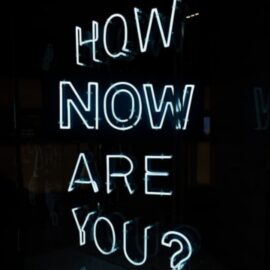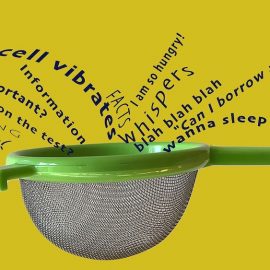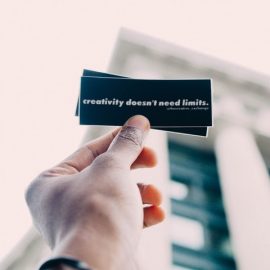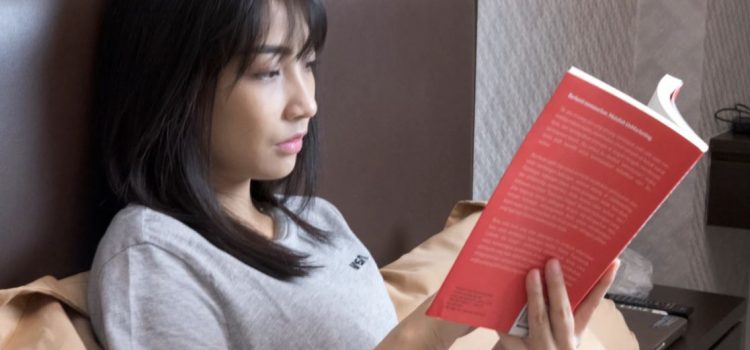
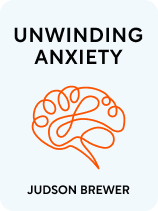
This article is an excerpt from the Shortform book guide to "Unwinding Anxiety" by Judson Brewer. Shortform has the world's best summaries and analyses of books you should be reading.
Like this article? Sign up for a free trial here.
What is the book Unwinding Anxiety about? What are the main takeaways of the book?
In Unwinding Anxiety, Brewer explains how anxiety becomes a habit and how it spawns additional habits that only make things worse. Brewer shows why mindfulness succeeds where traditional methods like willpower, substitution, and avoidance fail.
Read below for a brief overview of Brewer’s book Unwinding Anxiety.
Unwinding Anxiety by Dr. Judson Brewer
Anxiety is sneaky. It lives in our thoughts and habits, and it can show up as a stomachache or a 3 a.m. Netflix binge. But according to Dr. Judson Brewer, there’s a reliable way to recognize and dismantle anxiety and the harmful habits it spawns. In his book Unwinding Anxiety, Brewer argues that you can defeat anxiety with mindfulness—the practice of paying close attention to the present moment without analyzing or judging it. Brewer walks through the neuroscience of anxiety and mindfulness and provides a set of practical techniques you can use to improve your life by overcoming anxiety and other unwanted habits.
Brewer (MD and Ph.D.) is a psychiatrist and neuroscientist who researches mindfulness—how it affects the brain and how it can be used to treat habits and addictions. He’s given a TED Talk on habit change and co-founded a company that makes app-based treatment programs for anxiety, eating disorders, and smoking using the same approach outlined in this book. He defines anxiety as an addiction and recommends treating it with his mindfulness-based habit change methodology. Unwinding Anxiety is aimed at readers looking to treat their own anxiety without medication or professional intervention.
Part 1: The Habit of Anxiety
Before we get into Brewer’s practical advice, it’s important to consider the theoretical context for his recommendations. Brewer’s guidelines for overcoming anxiety are based on his definition of anxiety as a habit loop. In order to understand how to break the cycle of anxiety, we first have to understand how a habit loop works and how anxiety in particular spins off into other habit loops.
What Exactly Is Anxiety?
Brewer never formally defines anxiety—in fact, he argues that it’s hard to define, and that you might not even realize you’re experiencing it. That’s because it can show up with explicit symptoms like worrying, a racing heart, jittery sensations, or panic attacks—but it can also manifest as seemingly unrelated physical complaints like stomachaches or as behavioral issues like overworking. But still, it seems worth knowing exactly what we mean by anxiety before we set about trying to treat it.
In Emotional Intelligence, author and psychologist Daniel Goleman offers a more in-depth definition of anxiety that might help us here. According to Goleman, anxiety is chronic worrying—and while the point of worry is to help us anticipate problems, in anxiety, the worry spins out of control and we either worry about everything or about nothing in particular. (As we’ll see, this definition lines up nicely with Brewer’s description of anxiety as a habit loop.)
Goleman says that anxiety is generally either cognitive (consisting mostly of worrying thoughts) or somatic (consisting mostly of bodily symptoms). He says that chronic anxiety tends to be fear-based (meaning you fixate on a specific situation), obsession-based (meaning you fixate on preventing certain situations), or panic-based (meaning you have panic attacks—episodes where you think you’re dying and experience symptoms similar to those of a heart attack).
Part 2: Breaking the Cycle
Once we understand how anxiety functions as a behavioral cycle, we can see that the solution to anxiety is breaking the cycle that creates and reinforces it. Brewer says this requires three steps:
- Recognize your anxious patterns as they arise.
- Pay close attention to your behaviors and their results so that you can determine whether any given behavior truly helps your situation.
- When you notice unhelpful behaviors, replace them with more useful and rewarding ones.
Be aware that these steps aren’t strictly linear. When you’re first learning to work with anxiety, you’ll need to take them in order because each step builds on the one before it: You can’t deconstruct a behavior loop (step 2) that you haven’t even noticed (step 1), and you can’t replace behaviors (step 3) until you’ve determined whether they need to be replaced (step 2). But because behavior change is an ongoing practice, you’re never really “done” with this process, and it’s completely normal (and necessary) to move back and forth between the steps.
Part 3: Mindfulness and Curiosity Practices
Now that Brewer’s covered the theory behind dismantling our anxious behavior loops, he delves into some specific practices that can help us through the three steps. First, he looks at a fundamental tool for mindfulness: watching the breath. Then he explores some practices for cultivating curiosity and expanding mindfulness throughout your daily life. To expand mindfulness in your daily life Judson suggests two techniques:
- Noting is a technique for avoiding distraction when you’re trying to be mindful
- Loving Kindness practice is a meditation technique whereby you offer positive wishes toward others and/or yourself to develop compassion, love, and joy.
Part 4: Troubleshooting
Now that Brewer’s discussed the whys and hows of mindfulness as an anti-anxiety technique in his book Unwinding Anxiety, he ends by looking at some of the obstacles you might encounter while trying to work with anxiety.
Is Anxiety Ever Beneficial?
To start with, Brewer points out that some people are uncomfortable with the idea of completely getting rid of anxiety, believing that a little anxiety is a necessary motivator. He dismisses this idea, arguing that the research it’s based on has been debunked and that many elite athletes and other performers appear totally relaxed when at their best.
Roadblocks to Change
Even if you fully buy into the goal of eliminating your anxiety, you might run into additional roadblocks, such as overthinking and beating yourself up.

———End of Preview———
Like what you just read? Read the rest of the world's best book summary and analysis of Judson Brewer's "Unwinding Anxiety" at Shortform.
Here's what you'll find in our full Unwinding Anxiety summary:
- How to recognize and counteract anxiety with mindfulness
- Why anxiety becomes is toxic if left untreated
- A three-step method for treating anxiety

